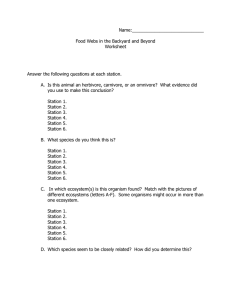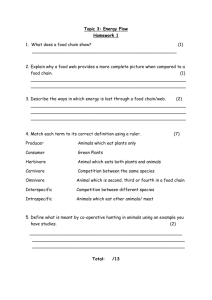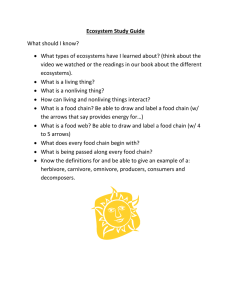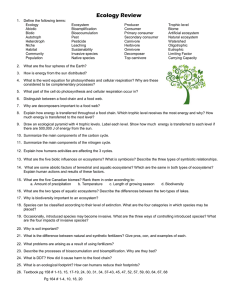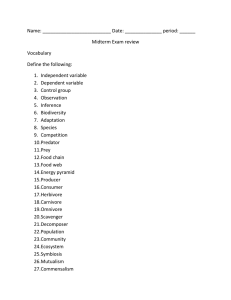Ecosystems unit • Today’s Big Ideas:
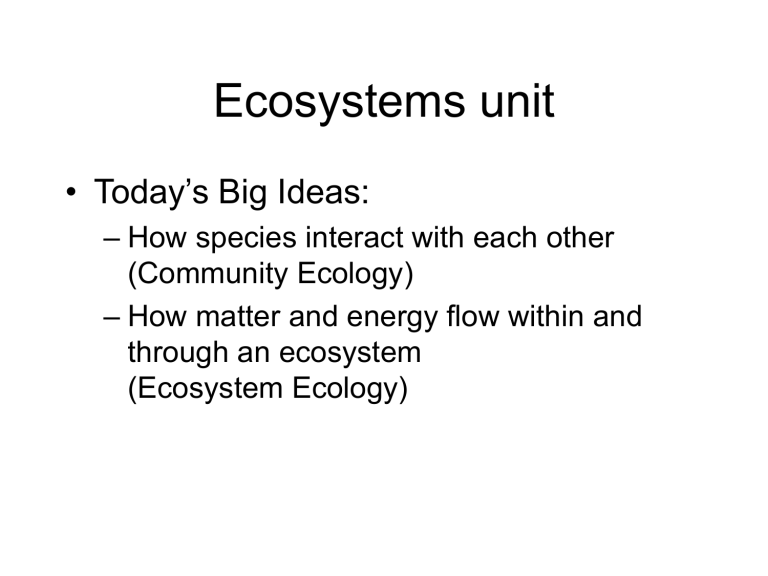
Ecosystems unit
• Today’s Big Ideas:
– How species interact with each other
(Community Ecology)
– How matter and energy flow within and through an ecosystem
(Ecosystem Ecology)
COMMUNITY ECOLOGY
– An organism’s biotic environment includes
• Other individuals in its own population
• Populations of other species living in the same area
– An assemblage of species living close enough together for potential interaction is called a community.
Interspecific Interactions
– Interspecific interactions are interactions between species.
• Interspecific Competition
• Mutualism
• Predation
• Herbivory
• Parasites and Pathogens
Interspecific Competition ( –/–)
– In interspecific (between species) competition , the population growth of a species may be limited by
• The population densities of competing species
• By the density of its own population
Mutualism (+/+)
– In mutualism , both species benefit from an interaction.
– One example is the mutualistic relationship of coral animals and the unicellular algae that live inside their cells.
• The coral gains energy from the sugars produced by the algae.
• The algae gain
– A secure shelter
– Access to light
– Carbon dioxide
– Ammonia, a valuable source of nitrogen
Predation (+/ –)
– Predation refers to an interaction in which one species
(the predator) kills and eats another (the prey).
– Numerous adaptations for predator avoidance have evolved in prey populations through natural selection.
Herbivory (+/ –)
– Herbivory is the consumption of plant parts or algae by an animal.
– Plants have evolved numerous defenses against herbivory, including
• Spines
• Thorns
• Chemical toxins
Parasites and Pathogens (+/ –)
– Plants and animals can be victims of
• Parasites , an animal that lives in or on a host from which it obtains nutrients
• Pathogens, disease-causing
– Bacteria
– Viruses
– Fungi
– Protists
(Malaria)
Trophic Structure
– Trophic structure is the feeding relationships among the various species in a community.
– A community’s trophic structure determines the passage of energy and nutrients from plants and other photosynthetic organisms
• To herbivores
• And then to predators
Plant
A terrestrial food chain
Producers
Phytoplankton
An aquatic food chain
Figure 20.15-1
Primary consumers
Herbivore Zooplankton
Plant
A terrestrial food chain
Producers
Phytoplankton
An aquatic food chain
Figure 20.15-2
Secondary consumers
Carnivore
Carnivore
Primary consumers
Herbivore Zooplankton
Plant
A terrestrial food chain
Producers
Phytoplankton
An aquatic food chain
Figure 20.15-3
Tertiary consumers
Carnivore
Carnivore
Secondary consumers
Carnivore
Carnivore
Primary consumers
Herbivore Zooplankton
Plant
A terrestrial food chain
Producers
Phytoplankton
An aquatic food chain
Figure 20.15-4
Quaternary consumers
Carnivore
Carnivore
Tertiary consumers
Carnivore
Carnivore
Secondary consumers
Carnivore
Carnivore
Primary consumers
Herbivore Zooplankton
Plant
A terrestrial food chain
Producers
Phytoplankton
An aquatic food chain
Figure 20.15-5
– Detritivores , which are often called scavengers, consume detritus , the dead material left by all trophic levels.
– Decomposers are prokaryotes and fungi, which secrete enzymes that digest molecules in organic material and convert them into inorganic forms.
Food Webs
– Few ecosystems are as a simple as an unbranched food chain.
– Omnivores
• Eat producers and consumers
• Form woven ecosystems called food webs
What would happen if one of the predators in a food web were taken out?
Lab 09 will help us to understand the consequences
Some definitions:
Dominant Species a species in a community whose population is most abundant or which has the highest biomass. They may control what other species are present within the community.
Foundation Species “ecosystem engineer”; a species that plays a major role in shaping communities by creating and enhancing a habitat that benefits other species.
– A keystone species is a species whose impact on its community is much larger than its total mass or abundance indicates.
– Experiments in the 1960s demonstrated that a sea star functioned as a keystone species in intertidal zones of the Washington coast.
ECOSYSTEM ECOLOGY
– An ecosystem includes
• The community of species in a given area
• All the abiotic factors, such as
– Energy
– Soil characteristics
– Water
– A simple terrarium is a microcosm that exhibits the two major processes that sustain all ecosystems:
• Energy flow , the passage of energy through the components of the ecosystem
• Chemical cycling , the use and reuse of chemical elements such as carbon and nitrogen within the ecosystem
Energy Flow in Ecosystems
– All organisms require energy for
• Growth
• Maintenance
• Reproduction
• In many species, locomotion
Energy Flows Through Ecosystems
– Watch energy flow animation on class website!
– Remember photosynthesis ! Sunlight energy is stored as chemical energy in glucose.
– Remember cellular respiration ! Chemical energy stored by plants is harvested by the organism to do work and is released as heat.
– You will see that at each step, the total amount of energy in the system decreases…. WHY?
– http://facweb.northseattle.edu/csheridan/Biology160_Wi n11/movies/20_25energy_flow.html
– (There is no sound for this animation. Keep pressing the
“Play” button to progress through the animation)
Why did the energy decrease at each step?
Let’s look at how much energy we start with in an ecosystem:
Primary Production
– The amount, or mass, of living organic material in an ecosystem is the biomass .
– The rate at which an ecosystem’s producers convert solar energy to the chemical energy stored in biomass is primary production
Open ocean
Estuary
Algal beds and coral reefs
Desert and semidesert scrub
Tundra
Temperate grassland
Cultivated land
Northern coniferous forest (taiga)
Savanna
Temperate broadleaf forest
Tropical rain forest
Lots of primary production!
0 500 1,000 1,500 2,000 2,500
Average primary productivity (g/m 2 /yr)
Why did the energy decrease at each step?
Let’s look at how much energy is available to each trophic level as we move through a food chain:
Ecological Pyramid
– When energy flows as organic matter through the trophic levels of an ecosystem, much of it is lost at each link in the food chain.
This energy is stored as biomass and is then available to the next consumer
– A pyramid of production illustrates the cumulative loss of energy with each transfer in a food chain.
– The energy level available to the next higher level
•Ranges from 5–
20%
•Is illustrated here as 10%
– The energy available to top-level consumers is small compared to the energy available to lower-level consumers.
– This explains why
• Top-level consumers require more geographic area
• Most food chains are limited to three to five levels
Chemical Cycling in Ecosystems
– Life depends on the recycling of chemicals.
• Nutrients are acquired and waste products are released by living organisms.
• At death, decomposers return the complex molecules of an organism to the environment.
• The pool of inorganic nutrients is used by plants and other producers to build new organic matter.
The Carbon Cycle
– The cycling of carbon between the biotic and abiotic worlds is accomplished mainly by the reciprocal metabolic processes of
•Photosynthesis
•Cellular respiration
Watch Carbon cycle animation on class website!
(Click “Hide quantities”) http://facweb.northseattle.edu/csherid an/Biology160_Win11/movies/20_32c arbon_cycle.html
Light
Autotrophs
Producer
Energy
Chemical elements
Heterotrophs
Herbivore
(primary consumer)
Carnivore
(secondary consumer)
Detritus
Decomposer
Inorganic compounds
(chemical elements)
Figure 20.UN04
